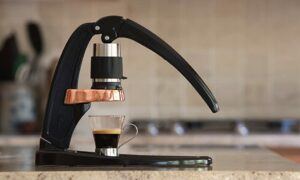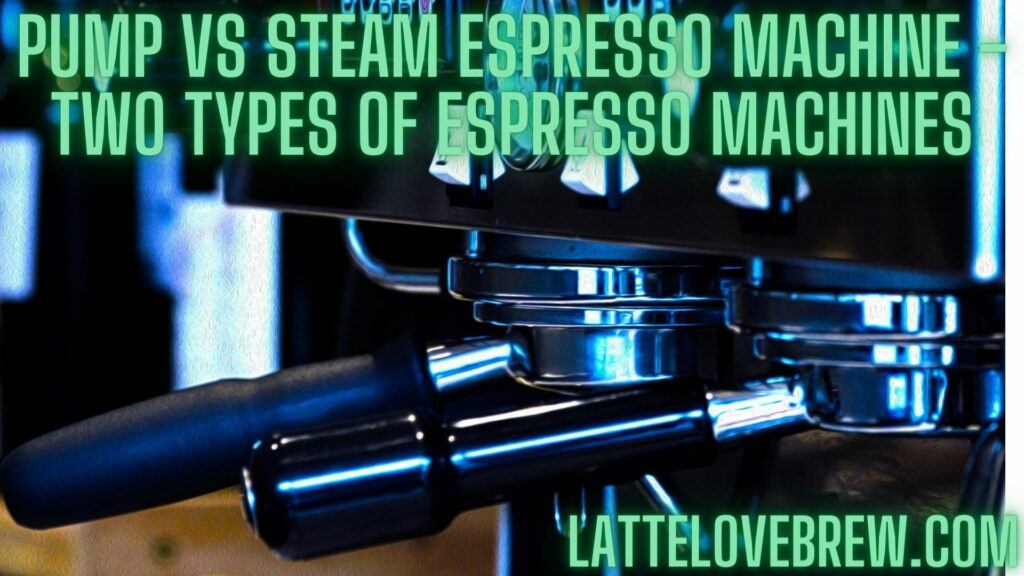Last updated on January 22nd, 2024 at 13:33
A home espresso machine is exactly what you will need to make world-class and barista quality coffee from home. You must, absolutely must get the right machine, which sparks the debate about Pump Vs Steam espresso machine.
By the time you have finished reading this article, you will know about vibratory pump espresso machines, rotary pump espresso machines and Steam pressure espresso machines.
You will be well-educated on which is best for your own coffee making needs.
Stay focused and keep reading.
The Pump Espresso Machine – What Is A Pump Espresso Machine?
Table Of Contents
- 1 The Pump Espresso Machine – What Is A Pump Espresso Machine?
- 2 Espresso Machine Pump Types
- 3 Hand Pump Espresso Machine
- 4 What Is A Steam Pressure Espresso Machine
- 5 Pump Vs Steam Espresso Machine Which Is Best?
- 6 Frequently Asked Questions About Pump Vs Steam Espresso Machine
- 7 Frappé-Ing It All Up – Pump Vs Steam Espresso Machine
Pump espresso machines function with the use of an electric pump that drives your pre-heated hot water through the brewing chamber and into the bed of ground coffee at the grouphead. An electric pump helps you to achieve and maintain consistent high pressure.
The technology is not new – it has been around since the early 1960s and is the more popular and commonly used type of espresso machine.
The plus point that makes this type of espresso machine a hit with baristas and coffee shop owners is its ease of maintaining a consistent pressure of heated water through the brew chamber, resulting in an espresso shot that is perfectly brewed.
There are 3 different categories for pump espresso machines – all based on how automatic they are: semi-automatic, automatic and, of course, super automatic.
With these there are different categorizations based on the number of boilers, the type of pump and sophisticated computer sensors that are programmable for your presets.
The advantage of the automatic or semi-automatic pump based espresso machine is the ability to control the output with consistency. This is also the reason for the more expensive and professional top end pump machines having multiple boilers.
Thanks to the multiple boilers, separate water is used to brew your cup of espresso and the steam to heat the milk for your espresso. Because of which, you have less probability of over extraction and far better control of the temperature.
The result of which is a much better, and rather excellent espresso and espresso based beverages.

Read: How do espresso machines work?
Espresso Machine Pump Types
There are two main types of pump-powered espresso makers, which are vibratory pump espresso machines and rotary pump espresso machines. Let’s talk about those.
Vibratory Pump Espresso Machine
Water needs to be put under pressure and then literally forced through a bed of tightly packed and finely ground coffee grounds to produce the crema for espresso.
Old style espresso makers were able to produce the pressure required of 130 PSI or 9 bars were manually pulled by means of a pump. This, for coffee lovers and coffee geeks is where the term ”to pull” an espresso originates.
Modern espresso machines no longer work using a manual pump, and they use an electric pump either a vibratory pump espresso machine or a rotary pump.
A vibratory pump, has a piston that moves back and forward powered by a magnet that is set inside a metal coil. When this happens, water is pushed through the espresso machine. On average, it pumps 60x per second.
The benefits of a vibratory pump is that it is cheaper and easier to replace. The downside is the pump has a shorter lifespan, which can 6 to 7 years if maintained well.

Rotary Pump Espresso Machines
A rotary pump is mechanical and complex. As the name suggests, it uses rotation. An electric motor spins a circular disc that is inside a larger round chamber. The disc that rotates is segmented into sections, as it spins pressure is created with the water entering during the large phase and exiting at the shorter phase.
The benefits of a rotary pump are that it is quieter to operate and has a very long lifespan of 10 years+. The drawback is they are much larger.
Hand Pump Espresso Machine
Briefly touched on earlier and worthy of a mention is hand pump powered espresso makers as they are making a comeback and rightly so.
Manual hand pump style espresso machines give the barista full control over all the variables that go into brewing a great espresso, a truly top quality espresso. They take quite a bit of time and practice for you to get a high degree of consistency to get it right every single time.
These lever machines I love.
An aeropress is simply a minified portable compacted version of this. Good for travelling and a little more.

What Is A Steam Pressure Espresso Machine
A steam pressure espresso machine works based on the original principles by Angelo Moriondo from 1884. This type of model is only capable of creating 3 bars of pressure, which is only 1/3 of what is required to produce a proper cup of espresso with a good thick crema on top that coffee lovers look for.
Steam machines are reliant on a tank of water that is manually filled and regularly filled. The water tank or boiler then heats the water to almost boiling point to create steam in the internal chamber. The steam then forces out the almost boiling water, which then passes through the group head and through the ground coffee beans and portafilter and, viola an espresso.
Steam machines, and the old-fashioned way, lack the pressure for making a great espresso – okay is what you get at best and the low-end steam-powered espresso maker can be difficult to maintain and get the correct temperature for making an espresso.
Pump Vs Steam Espresso Machine Which Is Best?
It all comes down to the quality of taste and consistency of results. The low and often inconsistent pressure of steam machines rules them out right off the bat. The resulting coffee from them is more like percolator coffee or reverse moka pot than a good, strong authentic espresso.
A steam machine is still reasonably good for other coffee drinks such as a Caffe Americano.
This leaves you with a choice of the 3 types of pump based espresso machines. There is not a lot between a vibratory pump machine and a rotary pump machine. Both are capable of making authentic espresso and espresso-based beverages. This is in absolute no doubt at all.
While I do like and have used rotary pump machines myself and I do like them, a much better level of consistency for brewing espresso and coffee shop style espresso drinks will be achieved with a vibratory pump based espresso machine.
An automatic machine or semi-automatic should see you making barista quality drinks at home. There is no need, in my opinion, for super automatic. The super automatic ones are too automatic and take away the difference and benefit that a skilled home barista has.
Hand pump manual espresso machines are also a great choice, but only for the occasional coffee as they can be annoying to operate to get the shot perfect and take a degree of experience and getting use to – I like them, but they do lack the convenience of automation that comes with an automatic vibration pump automatic or semi-automatic espresso machine.
Frequently Asked Questions About Pump Vs Steam Espresso Machine
What Is The Difference Between Steam And Pump Espresso Machines?
Steam espresso machines are the old-fashioned style and only produce one or two bars of pressure, which is nowhere near enough to produce a beautiful thick and rich crema on top. Incidentally, a moka pot is capable of producing 1 to 1.5 bars of pressure.
A pump-driven espresso machine is a more modern design and produces 9 to 15 bars of pressure which is perfect for brewing espresso shots with a nice thick and tasty crema on top.
Is Espresso Made With Steam Or Water?
An espresso is made with hot water at the temperature range of 92C to 96C (195F to 205F) with the temperature nearer the 96C (205F). The hot water is forced through a bed of very fine ground coffee at a pressure of 9 bars (130 PSI).
Is Nespresso A Pump Espresso Machine?
There is a pump inside a Nespresso that can reach a pressure of 19 bar, but it is not a pump-driven espresso machine. A Nespresso is a single-serve capsule based coffee maker.
The brewing system is different to an espresso machine and is more like an advanced single cup drip coffee maker as the individual coffee pods use pressure, gravity and a tiny filter is below the coffee grounds in the coffee pod or capsule.
Do I Really Need An Espresso Machine?
If you enjoy making the kind of coffee that you see on the menu at Starbucks and will be making it regularly then you will not only get a lot of value you will save a lot of money from your trips to Starbucks.
If you really want that coffee shop experience at home then yes, in my opinion you will need an espresso machine.
What Is The Most Popular Espresso Machine In Italy?
The most popular espresso machine in Italy is the De’Longhi Magnifica. It’s a fantastic super-automatic espresso machine.
What Does The Steamer Do On An Espresso Machine?
The steam wand on an espresso machine is for making steamed milk and frothed milk for a wide range of espresso-based beverages like a latte, cappuccino, flat white, macchiato, mocha, cortado and more.
Frappé-Ing It All Up – Pump Vs Steam Espresso Machine
In the fight of pump Vs Steam espresso machine I’d love to tell you to get steamy but, when it comes to getting a great espresso you gotta pump it up and go for a vibratory pump espresso machine. I advise an automatic or semi-automatic version and skipping over a fully automatic vibratory pump espresso maker.
Join our online coffee community and feel free to share your coffee jokes, coffee memes, coffee creations and recipes. Find us on Facebook/Meta.







